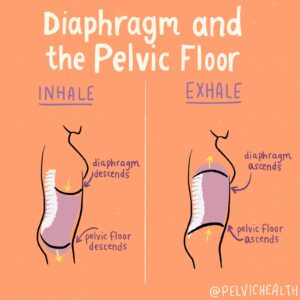The diaphragm and the pelvic floor: a coupled relationship.
This is SO IMPORTANT that I spend time teaching this to almost every single one of my pelvic floor and low back pain patients!! Don’t underestimate the importance of breathing!
The diaphragm and your pelvic floor work together like a piston. When you inhale, air fills your lungs and your diaphragm descends, increasing your intraabdominal pressure and allowing your pelvic floor muscles to lengthen/relax slightly. When you exhale, your pelvic floor returns to its normal resting state, and if you exhale all the air in your lungs, it can help your pelvic floor lift a little (not quite a full contraction or kegel).
“Diaphragmatic breathing” is when we allow the diaphragm to fully descend downwards and outwards (like a big umbrella opening). I prefer calling it “360 breathing” because I want you to send your breath all around your belly AND your low back, not just to your belly.
360 breathing can help with: decreasing stress, pelvic floor muscle relaxation, decreasing neck and jaw tension, improving pelvic and intestinal blood flow, digestion, and improving lymphatic flow in the abdomen and pelvis.
In times of high stress or chronic pain, we tend to switch from 360 breathing to chest breathing. This causes us to lose out on all the benefits of diaphragmatic breathing and actually perpetuates our pain/stress cycle. Scroll down to re-learn how to do 360 breathing correctly.

Technique 1.
360 Breathing without actively contracting your pelvic floor:
- Perform this first as a way to help calm your nervous system and relax your pelvic floor to a calm resting state.
- You can try this sitting or laying on your back with your legs bent or straight, whichever is most comfortable.
- Relax your jaw by placing your tongue on the roof of your mouth and keeping your teeth slightly apart.
- Place one hand on your belly and the other on your chest.
- Take a deep breath in through your nose, letting your rib cage widen and your abdomen and low back expand. It’s common for your low back or belly to feel tight and for this to be challenging at first (psst: that means you’ve probably been chest breathing and you really need this!)
- When you inhale, you should feel your hand on your belly rise first and more than your hand on your chest.
- Keep your upper chest, neck, jaw, and shoulders relaxed as you breathe in.
- As you breathe out through your open mouth, allow your abdomen to relax. Exhale completely.
- Breathe slowly. Do not force your breathing. Practice this for a few minutes, or however long feels right for you.
How do you feel after practicing this? Do you feel more relaxed? You should! Super nerdy fact: as the diaphragm descends downwards, it strokes the Vagus Nerve, which is the nerve that controls your body’s rest/digest system. This means that by practicing 360 breathing, you are literally stimulating your body to relax. How cool is that?!
Technique 2.
360 Breathing with active pelvic floor contraction
Note: this is not something I recommend to patients with ongoing pelvic pain, pain with intercourse, vulvar pain, or difficulty with bowel movements. If you are experiencing these symptoms, please practice technique #1 only.
- Once you have conquered the ability to fully relax the pelvic floor with 360 breathing, you can consider practicing 360 breathing with contracting your pelvic floor. Make sure you have fully conquered 360 breathing before moving on to this step. It can often take weeks to learn to learn 360 breathing and to coordinate fully relaxing the pelvic floor.
- Lay on your back with your legs bent or straight, whichever is most comfortable
- Relax your jaw by placing your tongue on the roof of your mouth and keeping your teeth slightly apart.
- Place one hand on the lower part of your abdomen and the other on your chest.
- Take a deep breath in through your nose, letting your rib cage widen and your abdomen expand.
- You should feel your hand on your abdomen rise first and more than your hand on your chest.
- Keep your upper chest, neck and shoulders relaxed as you breathe in.
- As you breathe out through your mouth, blow out like you are blowing air through a straw. Allow your abdomen to relax and exhale completely.
- Now focus on the relationship between your breathing, diaphragm, and the pelvic floor muscles. 9. As you breathe in, allow your pelvic floor to relax and lengthen.
- Now, as you exhale, close and contract/lift up the pelvic floor up (Kegel), as if the pelvic muscles are helping the air leave your lungs.
- Continue to do your diaphragmatic breathing, working on coordinating your inhale with pelvic floor relaxation/lengthening and your exhale with pelvic floor close and lift.
- Breathe slowly. Do not force your breathing. Practice this for a few minutes, or however long feels right for you.
- When you are finished, make sure to fully relax the pelvic floor by performing a few 360 breaths without contracting (the first technique you learned!)
